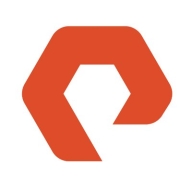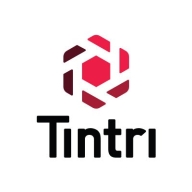


Find out in this report how the two All-Flash Storage solutions compare in terms of features, pricing, service and support, easy of deployment, and ROI.
By opting for the gold subscription every three years, you get a free upgrade to the latest controller release.
If you wait more than seven years to buy another one, you get a return on your investment.
I accidentally had a volume or VMstore running up to 95%, but it was no issue. The performance was still top-notch despite being used over 90%.
We also had one outage where a controller of one of the products had failed and had to be replaced on-site.
Customers always have their issues resolved promptly.
Pure has good storage.
Their support team provides excellent assistance and effectively addresses issues.
It is highly scalable.
It is suitable for both medium-sized and enterprise businesses.
It hasn't broken down anytime in the last six to seven years, despite hurricanes, earthquakes, and power outages.
I rated the scalability as seven because even though the solution can scale, load balancing must be done manually, as it's not automated.
You do not need to purchase fully populated or maxed-out boxes on day one; instead, you can start with half-populated boxes and expand as your needs grow, adding disks as necessary.
During the eight years, there have been no problems such as hardware failure or stopping.
I would rate the stability of the solution as a ten out of ten.
I would rate the stability of the product at seven out of ten.
A new controller was shipped and arrived the next day.
We would appreciate a built-in transparent failover in the next release to eliminate the need for a separate metro cluster.
I'm eagerly anticipating the roadmap's promise of introducing multiple controllers, which could significantly boost scalability and resilience.
We mostly rely on long-term releases. We don't need the most up-to-date features, but we need a reliable environment.
I suggest Nasuni improve their syslog forwarders to support TCP protocol, as it's more secure than UDP, which is plain text and not protected at all.
Tintri could improve by ensuring shorter times for support and compatibility when there are new releases from partners like VMware or Microsoft.
Maybe some sort of spreadsheet or visual tool would help. It could show the amount of data and servers we have, guide us on which particular build to choose, and estimate costs.
While the prices may be higher than those of other vendors, we see it as a market leader with benefits.
The support can be a bit pricey, but the solution is more cost-effective than anything else out there.
I would give it a nine out of ten in terms of costliness.
I prefer solutions with lower pricing.
While it might seem expensive per gigabyte initially, the practical capacity and the reduced need for additional backup and storage personnel make it fairly priced.
Pure Storage has signature security technology, which cannot be deleted, even if you are an administrator.
The platform's robust features include excellent sustainability tracking, and a comprehensive dashboard offering insights into IOPS, bandwidth, performance, and virtual activities.
Its data compression feature is the best that we have ever seen.
The features I find most valuable in Nasuni are the unlimited snapshots, antivirus capabilities, auditing, and ransomware protection.
It is hands-off and runs seamlessly without needing daily management.
I have eliminated bottlenecks with storage and have a more secure storage platform using unwritable snapshots.



| Company Size | Count |
|---|---|
| Small Business | 15 |
| Midsize Enterprise | 11 |
| Large Enterprise | 12 |
| Company Size | Count |
|---|---|
| Small Business | 3 |
| Midsize Enterprise | 8 |
| Large Enterprise | 24 |
| Company Size | Count |
|---|---|
| Small Business | 22 |
| Midsize Enterprise | 27 |
| Large Enterprise | 19 |
Pure Storage FlashArray//X is the world’s first enterprise-class, all-NVMe flash storage array. It represents a new class of storage – shared accelerated storage, which is a term coined by Gartner – that delivers major breakthroughs in performance, simplicity, and consolidation.
Nasuni is a file data services enterprise focused on assisting firms with their digital transformation, global expansion, and information awareness. The Nasuni File Data Platform is a suite of cloud-based services designed to enhance user productivity, ensure business continuity, provide data intelligence, offer cloud options, and simplify global infrastructure. This platform and its auxiliary services are projected to replace conventional file infrastructure such as network attached storage (NAS), backup, and Disaster Recovery (DR), with an expandable cloud-scale solution. By storing file data in scalable cloud object storage from multiple providers, Nasuni positions itself as a cloud-native alternative for traditional NAS and file server infrastructure. Based in Boston, Massachusetts, USA, Nasuni serves sectors like manufacturing, construction, technology, oil and gas, financial services, and public sector worldwide, offering its services in more than 70 countries.
James J., IT Manager at a marketing services firm, says Nasuni’s management dashboard is helpful because he's able to view all of the different filers at once rather than check each one of them individually. He values the software’s security, reliability, good performance, helpful alerting, and responsive support.
According to a Server Engineering Services Lead at a mining and metals company, Nasuni offers good OR and DR capabilities, performs well, offers data security, and continuous file versioning helps recover from hardware failures.
The Managing Director of IT at a construction company appreciates Nasuni because it eliminates a lot of work that was previously done when managing backing up and restoring data files.
For over 10 years, Tintri has been unburdening IT teams of tedious, manual data management with the most advanced, AI-enabled solution on the market. With a commitment to ongoing R&D, Tintri delivers an infrastructure solution built for today’s future-ready, integrated operations from the ground up. We are redefining what data management and analytics look like for today’s dynamic workloads.
Tintri VMstore Adds Feature That No Other Platform Offers
The Tintri VMstore T7000 Series is the latest addition to the storage industry’s only true Intelligent Infrastructure portfolio. The T7000 delivers NVMe driven performance and efficiencies, supporting up to 7,500 virtualized applications in just two rack units. It offers the kind of scalability, availability and security that you’d expect from an enterprise-grade system that powers numerous Fortune 100 firms. Our customers love the outstanding AI-driven efficiency and optimizations that set VMstore apart from traditional approaches. VMstore systems deploy in minutes, self-optimize and dynamically adapt to accommodate the most demanding workloads in the data center maintaining quality of service (Auto-QoS) for each Virtual Machine (VM). Autonomous operations and advanced real-time and predictive analytics consistently drive down storage management activities and costs – by as much as 95%.
Tintri VMstore T7000 – NVMe Platform Datasheet
Tintri VMstore simplifies and automates storage management, delivering real-time analytics, and maximizing performance so you can refocus your efforts on high-impact projects and business innovation.
We monitor all All-Flash Storage reviews to prevent fraudulent reviews and keep review quality high. We do not post reviews by company employees or direct competitors. We validate each review for authenticity via cross-reference with LinkedIn, and personal follow-up with the reviewer when necessary.